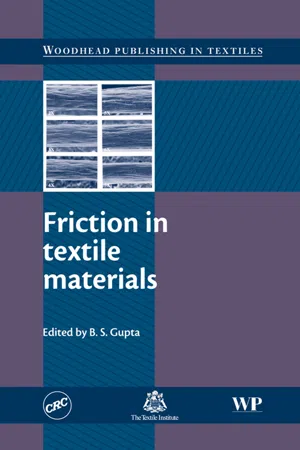
- 488 pages
- English
- ePUB (mobile friendly)
- Available on iOS & Android
Friction in Textile Materials
About This Book
Friction is a major issue in both the production of textiles and in the finished product. This authoritative book reviews how friction occurs and the ways it can be measured and controlled.The book begins by looking at how friction can be defined and how the structure and properties of textile fibres lead to friction behaviour. It also discusses slip-stick phenomena in textiles and ways of measuring friction in yarns and fabric. The second part of the book reviews friction in particular textiles, including cotton, wool and synthetic fibres as well as woven fabrics. These and other chapters also discuss ways of controlling friction, including fabric finishes and lubricants.With its distinguished editor and contributions from some of the world's leading authorities in the subject, Friction in textile materials is a standard reference for the textile industry and those researching this important topic.
- An authoritative review of friction, its management and control
Frequently asked questions
Information
Textile fiber morphology, structure and properties in relation to friction
Publisher Summary
1.1 Introduction
1.2 Fiber classification
Table of contents
- Cover image
- Title page
- Table of Contents
- The Textile Institute and Woodhead Publishing
- Copyright
- Dedication
- Contributor contact details
- Woodhead Publishing in Textiles
- Preface
- Introduction
- Chapter 1: Textile fiber morphology, structure and properties in relation to friction
- Chapter 2: Fundamental concepts of friction and lubrication affecting textile fibers
- Chapter 3: Friction behavior of fibrous materials used in textiles
- Chapter 4: Stick-slip phenomena in textiles
- Chapter 5: Experimental methods for analyzing friction in textiles
- Chapter 6: Friction and surface characteristics of cotton fibers
- Chapter 7: Friction, felting and shrink-proofing of wool
- Chapter 8: Friction and surface characteristics of synthetic fibers
- Chapter 9: The role of fiber friction in staple fiber processing
- Chapter 10: Friction in woven fabrics
- Chapter 11: Finishes and treatments to control friction in textile fibers
- Chapter 12: Boundary lubrication phenomena in coated textile surfaces
- Index